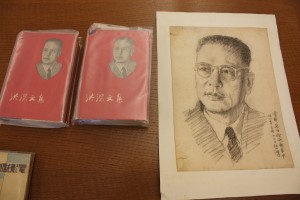 Performance of The Wedded Husband
Performance of The Wedded Husband
(Nov. 16 and 17, 2013)
Hong Shen Symposium
(Nov. 18, 2013)
The Ohio State University
Overview and Inception of the Project:
Hong Shen 洪深 (1894-1955)—one of the key figures in the worlds of modern Chinese theater, film, and drama—had some of the most formative experiences of his career at Ohio State University, where he studied ceramic engineering between 1916 and 1919. While at OSU, Hong wrote and produced two English-language plays: The Wedded Husband and Rainbow. He would go on to study drama at Harvard and then, in 1923, return to China, where he would become an important agent in the development of modern Chinese spoken drama and film and a major theorist of drama performance.
Hong wrote plays (most famous among which is Yama Zhao [赵阎王]), but he also wrote numerous screenplays and directed several films. Hong was also the author of several books on theater and film, including A Preliminary Knowledge of Theater Direction (劇導演的初步知識); Film and Performance Technique (電影戲劇表演術); Methods for Writing Film and Theater Scripts (電影戲劇的編劇方法); and Theatre and Poetry Recitation(戲的唸詞與詩的朗誦), making him one of the most important critical voices in film and drama production of the Republican era.
To honor his experience at OSU, Hong Shen’s daughter Hong Qian (洪钤) recently donated a collection of her father’s books and other artifacts to the OSU Library. In addition to early editions of most of Hong’s works, the donation included a sketch of Hong Shen by the renowned artist Xu Beihong (see image in the header of this page), an ink painting by the female playwright Zhao Qingge, photographs, and letters.
The Wedded Husband
To commemorate both Hong Shen’s experience at OSU and the donation, doctoral candidate Man He of the Department of East Asian Languages and Literatures is producing one of the plays—The Wedded Husband—that Hong wrote while at OSU nearly one hundred years ago. Directed by Steven Liu (University of British Columbia), the student production will be staged on Nov. 16 and 17 at the Roy Bowen Theater (OSU), with a matinee and evening performance each day.
Set in Tianjin “just after the Revolution, when nobles were still addressed by their titles and the people in general hesitated to break the old Chinese traditions,” The Wedded Husband is likely the first English-language play written by a Chinese. The play was performed with gender appropriate actors and a racially mixed cast to an audience of 1300 in April 1919. To our knowledge, it has not been staged since its premier in 1919.
The Film: Shanghai Old and New (新旧上海; 1936)
Hong Shen was a prolific screenwriter, working mostly with the Mingxing Film Production Company. As part of the Hong Shen activities, we will be screening a newly-subtitled (by DEALL doctoral student Sasha Draggeim) version of Shanghai Old and New, an early sound film directed by Cheng Bugao 程步高, with a screenplay by Hong Shen. The film initiated a trend in Chinese filmmaking in the late 1930s and 1940s to depict strata of social life through the intertwined stories of the residents of a small Shanghai apartment building.
Symposium:
In conjunction with the performances of The Wedded Husband, a symposium will be held on November 18, 2013, on the subject of Hong Shen and intermediality in modern Chinese cultural production. In recent years, scholars have increasingly begun to realize that the discrete cultural artifacts—books, films, journals, radio, records, and so forth—circulating in the early part of the twentieth century in urban China, particularly in Shanghai, cannot be studied in isolation from one another, but need to be considered as interconnected parts of a larger mediasphere. Since Hong Shen, perhaps to a greater degree than any of his contemporaries, was simultaneously active in multiple domains, his career, work, and networks provide an ideal lens through which to examine and disentangle how different forms of media converged to create new social, cultural, and political possibilities. The symposium brings together some of the leadings scholars of modern Chinese drama and film to put Hong Shen’s varied contributions in this larger cultural context.
Hong Shen and the Modern Mediasphere in Republican Era China
When and Where
Campus Reading Room (11th Floor), Thompson Library
The Ohio State University
Columbus, Ohio
Monday, November 18, 2013 / 9:00am
Morning Session
Kirk A. Denton (OSU): Opening Remarks
Steven Liu (University of British Columbia): The Role of Two Beijing Newspapers in the National Theatre Movement Debate
Xuelei Huang (University of Edinburgh): Mediating, Interlinking, and Multitasking: Hong Shen at the Mingxing (Star) Motion Picture Company, 1925-1937
Xiaomei Chen (University of California, Davis): Mapping a “New” Dramatic Canon: Rewriting the Legacy of Hong Shen
Afternoon Session
Man He (OSU): When S/He is Not Nora: Global Citizens, Chinese Dramatists, and Their Staging Experiences in 1910s America
Liang Luo (University of Kentucky): Hong Shen, Tian Han, and Intermediality
Megan Ammirati (University of California, Davis): Hong Shen and Gender-straight Casting: Inevitable Impersonations in Yama Zhao
Patricia Sieber (OSU): Concluding Remarks

